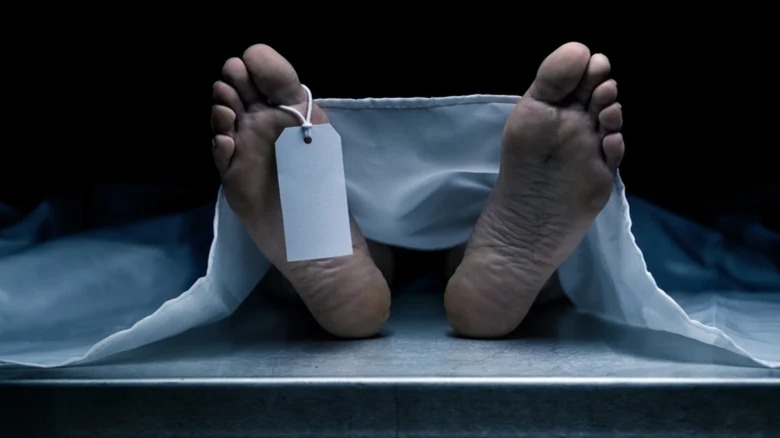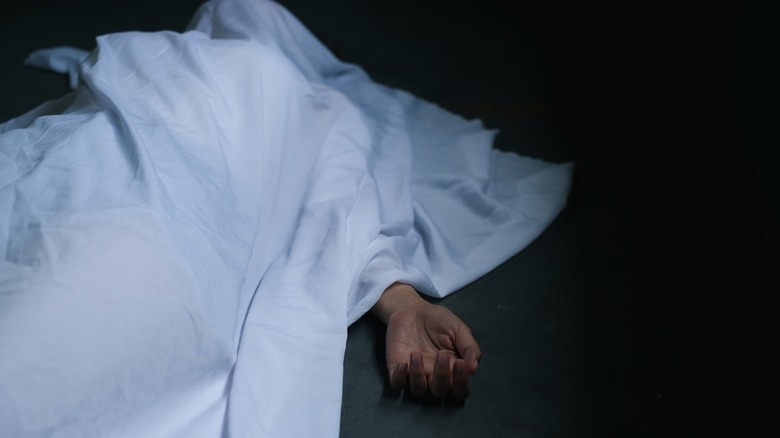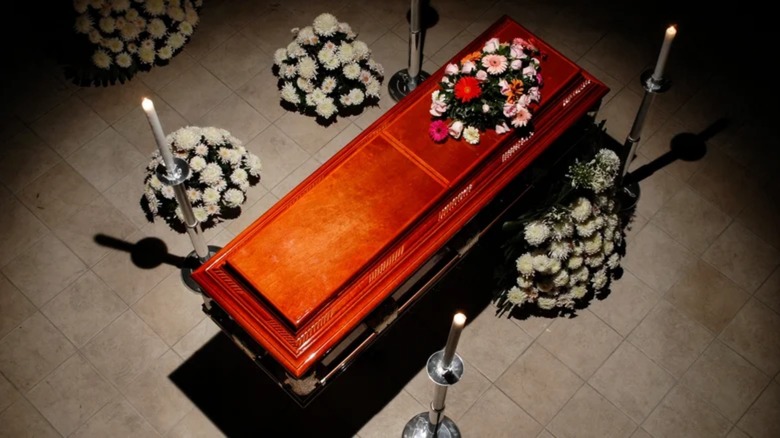What Happens To Your Body After You've Been Dead For An Hour?
The subject of death isn't generally considered pleasant, but nevertheless, most people have a strong sense of what it looks like from mainstream movies and TV. In such media — especially those films and TV shows made for a family audience, such as the early James Bond movies, or old Westerns — death is typically quick, with the hero shooting bad guys who fall to the ground in an instant like rag dolls. Elsewhere, in black comedies such as "Weekend at Bernie's," it seems that dead bodies can remain as they are at the time of death and be moved around like a puppet for days on end.
According to Verywell Health, by the time an hour passes after a person's death, all of their muscles have fully relaxed to the point that skin can sag, making certain bones more prominent. In fairer-skinned people, the skin likely looks paler because the blood has stopped pumping. The pupils dilate. If there is any excrement or urine in the body, it comes out.
Of course, it is also widely known that the body undergoes a process known as rigor mortis after death, in which it becomes stiff and unmoving. But rigor mortis isn't the first process that occurs in a dead human body — in fact, it happens hours later, after two other less-famous processes called algor mortis and livor mortis, each of which may begin to occur within an hour of death. More immediately, the cells of the body undergo something called autolysis, a cellular phenomenon that affects all deceased organisms within minutes.
Autolysis
It isn't likely to be namechecked in crime dramas, but autolysis is one of the most fundamental things that happens to the body after death.
Writing for McGill University, Jonathan Jarry asks the question of what prevents a human body from decomposing while one is still alive. The answer is the circulatory system, which supplies the cells throughout our body with the oxygen that keeps them operational and intact. However, when a person ceases to breathe at the point of death, cells are no longer provided a supply of oxygen through the blood and, as a result, their structures start to collapse.
The cell walls, also known as the cell membranes, which are typically robust during life, break apart and allow the hydrolytic cellular enzymes within to spill out. These enzymes then begin to eat away at the surrounding cellular matter, beginning the long process of decomposition on a level not observable to the naked eye.
Algor mortis and livor mortis
Of the numerous processes that a body may undergo an hour after death, algor mortis is the one a majority of people might be aware of from popular culture. It means "cold death" in Latin, and put simply, it's the process by which a dead body begins to drop in temperature, cooling from the average temperature of a live human body to the ambient temperature of the air around it.
Depending on various factors, livor mortis can take place as soon as 30 minutes after a person dies, but is usually visible after about an hour, or as much as three hours later, making it another process that a body in question would possibly be undergoing at the one-hour mark. Livor mortis involves the blood — which has ceased to circulate — being acted on by gravity so that it leaves the higher part of the body and pools in the blood vessels closest to the ground. This leads to a reddening, or "lividity," in those parts of the body. Though algor mortis and livor mortis would likely occur simultaneously, they are not directly related, and it is likely that algor mortis could certainly set in before livor mortis commences.
When does rigor mortis occur?
Rigor mortis occurs as a result of the cessation of the respiratory system, which supplies oxygen to the muscles of the body and creates adenosine triphosphate, allowing the muscle fibers to move. In the period immediately following death, the muscles still have malleability, but after respiration comes to an end, acids and elements such as calcium fill the muscle tissue and stretch it rigid, sending the body into a period of paralysis. Rigor mortis tends to begin around three to four hours after death, has taken effect on the whole body within 12, and lasts around three days if the body is unrefrigerated, after which the stiffness subsides, allowing the body to be prepared for burial or cremation.
So how do algor mortis and livor mortis compare to rigor mortis in terms of timeline, and can they overlap? Certainly, such processes take place over the course of several hours, and, as such, the dropping of temperature and increasing lividity in the lower parts of the body might certainly continue as rigor mortis sets in. Taken together along with autolysis, which is the self-destruction of living cells, they ultimately represent the beginning of the process of decomposition — the first step toward the body breaking down and eventual skeletalization.



